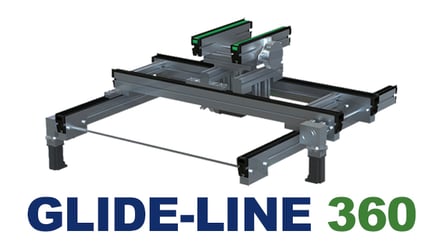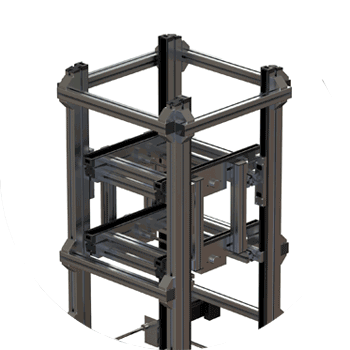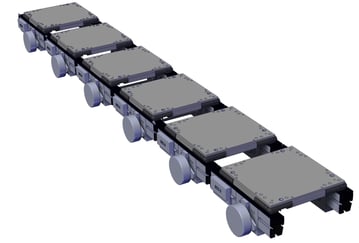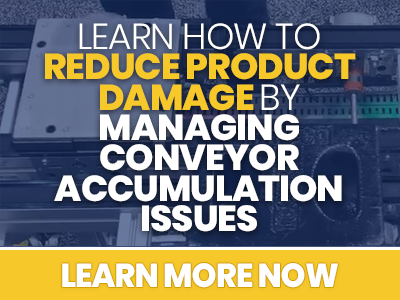 Conveyor design isn’t always the most exciting part of your automation system. But building an advanced, modular conveyor system can be a way for your system to showcase innovation and creative solutions in your production conveyor systems. Here are eight proven tips and creative ideas to keep in mind when engineering your next automated conveyor system.
Conveyor design isn’t always the most exciting part of your automation system. But building an advanced, modular conveyor system can be a way for your system to showcase innovation and creative solutions in your production conveyor systems. Here are eight proven tips and creative ideas to keep in mind when engineering your next automated conveyor system.
1. Start with what works for customer, your system, and your design, not what you know exists already in the world of conveyor options.
This is the most pertinent tip we can give you: always begin with your customer’s needs and what truly works for the system you’re designing. The best conveyor suppliers will be able to match your needs to a production conveyor system.
what truly works for the system you’re designing. The best conveyor suppliers will be able to match your needs to a production conveyor system.
Your current conveyor system supplier may not offer new, innovative options for pallet conveyor automation systems, modular conveyor systems, or multiple strand conveyor systems, but that doesn’t mean you (and your customer) need to be locked into existing options. Look for a conveyor supplier who offers components for unique solutions or unusual movements, but doesn’t see this as a custom request. In reality, innovation should never cease, and that includes innovations from your conveyor systems manufacturer.
2. Offer flexibility; don’t lock customers into existing conveyor designs.
When you aren’t locked into a specific set of conveyor options, you’re able to offer flexibility in your engineered designs of what a conveyor system is able to accomplish.
 Find a supplier who thinks outside the box and is already offering innovative solutions. For example, Glide-Line’s 360 is a combination of powered timing belt based linear actuators and conveyors working together to meet almost any type of orientation change, sort, or shift for your customer’s product in any space (even very small ones).This system allows for endless configurations and maximizes assembly workspace, including moving conveyors on a 45-degree angle. These types of innovation are available as a standard, not as a premium, which doesn’t limit your creativity.
Find a supplier who thinks outside the box and is already offering innovative solutions. For example, Glide-Line’s 360 is a combination of powered timing belt based linear actuators and conveyors working together to meet almost any type of orientation change, sort, or shift for your customer’s product in any space (even very small ones).This system allows for endless configurations and maximizes assembly workspace, including moving conveyors on a 45-degree angle. These types of innovation are available as a standard, not as a premium, which doesn’t limit your creativity.
As an example, one customer in the automotive lighting industry used our Glide-Line 360 and customized it to create a robotic assembly station. This station was a very large - 8’ by 8’ - VTU that could allow totes to be picked up and maneuvered inside the eight foot square. Their only other option for their station would have been a completely custom design from a traditional conveyor manufacturer. However, using Glide-Line, the modular conveyor was configurable as a standard option; they received the flexibility they needed from their conveyor automation integrator to creatively solve the need.
3. Become the go-to in creative automation systems engineering.
Innovative, flexible systems can become the hallmark of your success, making you the go-to in conveyor or automation integrators. So many options exist today to boost your authority in this field; establishing yourself as a creative integrator can go a long way in creating a positive reputation.
If creativity isn’t at the forefront of your designs currently, ask for help. Glide-Line’s expert engineers serve as resources for applications engineers seeking creative solutions and custom conveyor systems.
Use modular conveyors that are configurable to the point where you are essentially offering a customized product, but rely upon on a manufacturer who doesn’t charge a premium for this innovation. Conveyors that lift and locate a pallet when transferring from one conveyor to another, others that make assembly from the bottom of the conveyor easy to accomplish, and multiple strand timing belt conveyors arranged in unique ways are examples of existing creative solutions you may not be utilizing.
4. Think vertically.
 When it comes to conveyors, we tend to think only of products moving horizontally from A to B to C. This setup can use up much of the space the customer has to work with for their automation system design.
When it comes to conveyors, we tend to think only of products moving horizontally from A to B to C. This setup can use up much of the space the customer has to work with for their automation system design.
Instead, think vertically to creatively use the space, sending product from A to C and back to A, then to B. The more you’ve efficiently utilized the space, the more money and product the customer can make in the space they have, and the more conveyor systems (or other automation) you’re able to provide to them.
5. Adapt to existing parts whenever possible.
Reusing the customer’s current equipment in a new, advanced conveyor system can save the customer resources. And, using existing equipment doesn’t have to hinder innovations in the design of a modular conveyor.
For example, in general, all of Glide-Line’s conveyors can easily be adapted to run using an existing AC motor, DC motor, or servo-style motor if the customer already has one in place. This is done by adapting and customizing the gearbox flange attached to the conveyor itself, which would be needed no matter what. This re-use of the customer’s existing equipment can save money and lets the customer know that you’re conscious of their bottom line. This brings us to our next point.
6. Keep the customer’s bottom line in mind.
 The return on your customer’s investment with you hinges on your ability to efficiently create an automation system that meets their needs and, at the end of the day, makes them money. Maximize their ROI using innovations in your systems, reducing their delivery and installation times, and reducing the long-term maintenance needed.
The return on your customer’s investment with you hinges on your ability to efficiently create an automation system that meets their needs and, at the end of the day, makes them money. Maximize their ROI using innovations in your systems, reducing their delivery and installation times, and reducing the long-term maintenance needed.
When you’re designing automated conveyor systems, there are a number of ways to focus on reducing costs to your customer:
- Reduce maintenance and energy costs by reducing backpressure caused by accumulation using an indexing conveyor style instead of traditional conveyors. Instead of causing unnecessary wear and tear on the entire system by continuously running the conveyors, this style only runs when product approaches and has a permissive from downstream, maintaining distance between products to eliminate contact.
- Reduce damaged products by taking a more elegant approach to conveying products using a similar indexing conveyor style. Just like this style reduces wear on the machine itself, it also reduces damaged product by maintaining a gap between the product and reducing damage from product back-up.
A large refrigerator manufacturer currently uses Glide-Lines Zero Contact Zoned conveyor to index refrigerator doors. This solution works well for them because the faces of the doors can’t be scratched. This set-up allows the manufacturer to index for each operation without damaging the doors in the process.
- Increase speed in delivery and set-up. When choosing a conveyor manufacturer, focus on one whose processes are precise and fast. Ideally, conveyors should arrive assembled, which reduces on-location installation time as well as human error in assembling.
- Make maintenance easy for your customer. Some manufacturers build conveyor systems to be overly complex machines requiring three degrees and a double black belt to maintain. Others, Glide-Line included, make parts easily accessible should they need to be changed out or modified. When you have the choice, go for the latter; your customer will appreciate it.
7. Use an in-context configurator.
Saving your customers time is great; saving yourself time is even better. While many conveyor systems manufacturers offer a configurator that exports CAD blocks and works with SOLIDWORKS, Glide-Line is the only one offering an in-context configurator that adjusts everything from parts numbers to pricing to configurations in real-time. No more lead time waiting for a salesperson to get back to you with pricing or parts numbers; it’s all updated instantly using Glide-Lines IMPACT! software. Read all about it in this recent blog post, Leading-Edge Ways to Configure Your Conveyor For Your Automation System.
8. Time is money.
Spend less time revising original 3D CAD files, less time waiting for responses from a salesperson, and less time waiting for delivery when you choose the right tools and manufacturer. You’re able to get back to work faster - and so is your customer.
By using a software like IMPACT!, you have cut out the previously necessary “middle man,” plus the time it took to go back and forth for accurate pricing and modeling. Your customers receive beautiful 3D solid models upfront, and fast delivery of the system you engineered.
We hope these tips help you to up your game when integrating conveyors. Our recent ebook, Customized Conveyor Design Guide: From Configurable Conveyor Technology To Your Automation System, shows you more ways configurable conveyor technology impacts your concept automation strategy. Download it today.









Leave a Comment